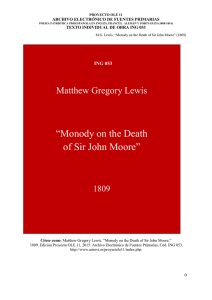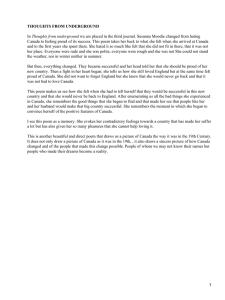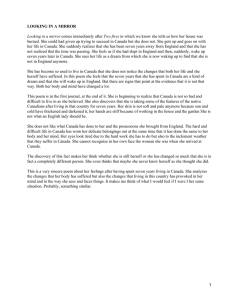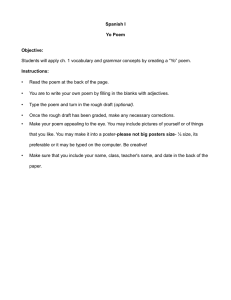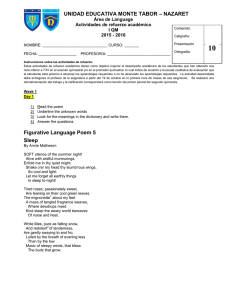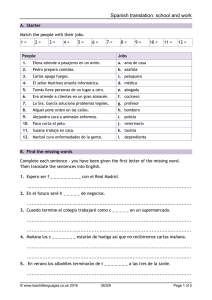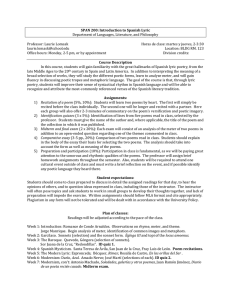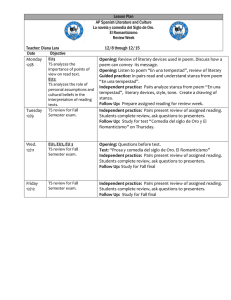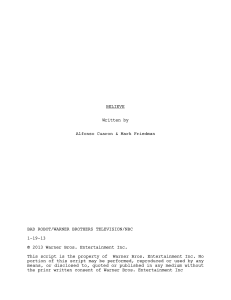A Poem on Sir John Moore at Corunna, by M.G. Lewis (1809
Anuncio
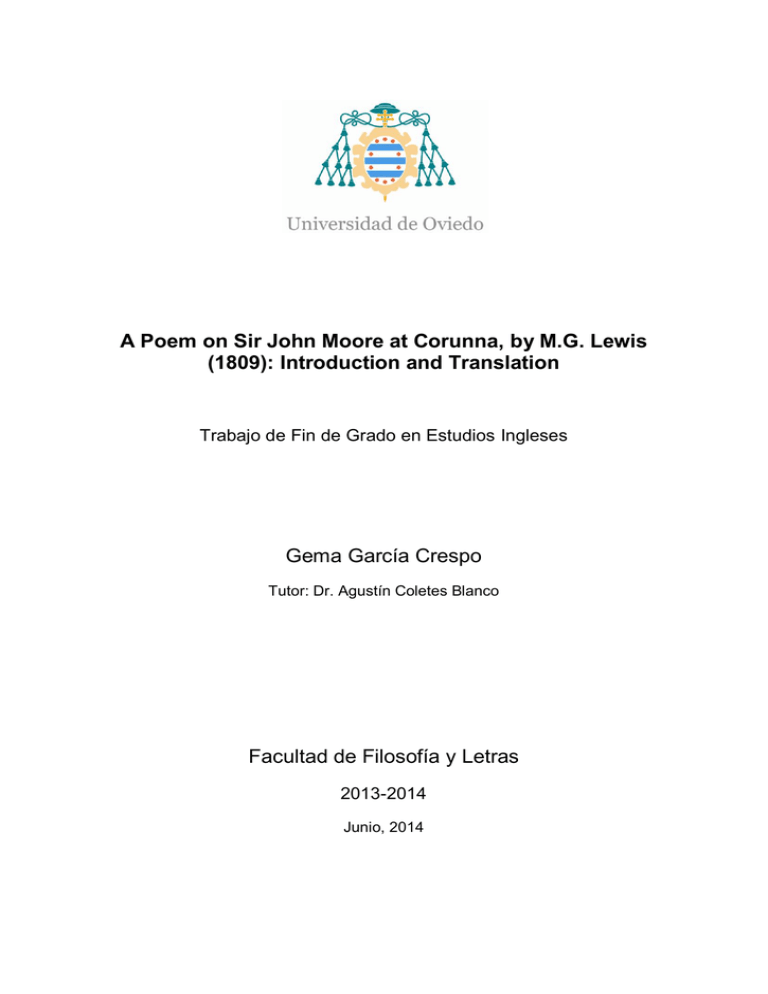
A Poem on Sir John Moore at Corunna, by M.G. Lewis (1809): Introduction and Translation Trabajo de Fin de Grado en Estudios Ingleses Gema García Crespo Tutor: Dr. Agustín Coletes Blanco Facultad de Filosofía y Letras 2013-2014 Junio, 2014 1 Index 1. Introduction ..................................................................................................... 2 2. The author: M.G. Lewis and his works on Spain ............................................... 3 3. The context: John Moore and the Peninsular War ....................................... 4 4. The poem (I) .................................................................................................. 10 4.1. Formal features.................................................................................................... 11 4.2. Content................................................................................................................ 12 4.3. Other aspects ....................................................................................................... 13 5. The poem (II) ................................................................................................. 14 5.1. Transcription ....................................................................................................... 14 5.2. Spanish Translation .............................................................................................. 18 5.3. Analysis................................................................................................................ 23 6. Conclusion ..................................................................................................... 29 7. Bibliography .................................................................................................. 31 2 1. Introduction To begin with, I would like to express my greatest gratitude to the people who helped me in the research and making of this dissertation, especially to Professor Agustín Coletes Blanco for his support and advice during the whole process. This study is based on the poem “Monody on the Death of Sir John Moore” by the British author Matthew Gregory Lewis. It was published on 1 st January 1809 in London. It was just one example of the many literary works written on Lieutenant-General Sir John Moore who led the British troops in the Battle of Corunna during the Peninsular War. He died in battle and was considered a hero. In this little-known poem, Lewis exposes Moore‟s virtues, those that had been praised by many in Britain and in Spain. “Monody on the Death of Sir John Moore” deals with one of the most important points in Anglo-Spanish relations, the Peninsular War. This war, as will be explained below, implied a series of changes in Spanish and British history that will remain until today. And this is the reason why a great amount of writers and other artists found inspiration in those days. Furthermore, the translation of this poem into the Spanish language will get Spanish speakers closer to a reality of Iberian history. This study is divided into seven main parts including the introduction, conclusion and bibliography. The second section focuses on the author and his links with Spain. The third section titled “The context: John Moore and the Peninsular War” introduces a short biography of Sir John Moore, whose life and death inspired this poem. It also includes an introduction to the topic of the Peninsular War and shows the importance of this conflict in Spanish and British history, focusing on the figure of Sir John Moore. Important data on the development of this conflict are collected chronologically in order to simplify reading. After this, the present paper will define and analyse the formal aspects of the poem, followed by an introduction to its content which includes a comparison with a much more famous contemporary work called “The Burial of Sir John Moore after Corunna” by Charles Wolfe. This poem, in spite of dealing with the same topic, uses different techniques and has a close relation with Lewis‟ poem, as will be explained below. 3 The next sections are dedicated to the transcription and translation of the poem. The subsequent translation analysis aims to explain some ofthe difficulties of translating poetry and, more specifically, the problems one faces when translating the poem under study. It goes through different aspects of poetry that can represent a handicap in the process of translation, specifically the ones that appear in Lewis‟ poem. In order to put together this study, special attention is paid to specific characteristics of poetry such as meter, highlighting its importance. 2. The author: M.G. Lewis and his works on Spain Matthew Gregory Lewis (1775 – 1818), novelist and playwright, was born in London and was the son of Matthew Lewis and Frances Maria Sewell. M. G. Lewis attended the Marylebone Seminary and the Westminster School after which he studied at Christ Church, Oxford in 1790, graduating with a bachelor‟s degree in 1794. He finally finished a master‟s degree from the same college in 1797. During his education, he was already creating literature. In 1791, he sent to his mother a copy of the farce The Epistolary Intrigue and produced some translations, specifically, the French opera Felix and Wieland‟s Oberon. The latter gained him the respect of the great author Johann Wolfgang von Goethe. While he was creating literary works, mainly to earn money for his mother, he was at the same time gaining a position as an attaché to the British embassy in The Hague thanks to his father‟s influences, where he spent some months in 1794. It was here where he wrote his best known piece of writing: Ambrosio, or The Monk published between 1795 and 1796 before he turned 20. This was a very polemical work dealing with morality topics. It was set in Spain and had the Inquisition as crucial element through the whole novel. However, The Monk was not the only Lewis‟ work connected to Spain. Among his works can be found his Romantic Tales where Lewis introduced some lines dedicated to King Rodrigo adding that his fall “is too well known to require any recital of it”. 1 Lewis was really interested in other works in different languages, especially German and Spanish, and he gathered a collection of Gothic poems and ballads taken 1 Matthew Gregory Lewis, Romantic Tales. (London: Printed by D.N. Shury for Longman, Hurst, Rees, and Orme, 1808), 263 4 from German and Spanish sources called Tales of Wonder. He included here the popular work “Ballad of Admiral Hosier‟s Ghost” written in the 18th century and based on the blockade of Porto Bello 2. Lewis was also closely connected to political affairs, especially to the Whig party. In fact, he got a seat in the House of Commons as a Whig Member of Parliament for Hindon in Wiltshire in 1796. He contracted yellow fever which resulted in his death during the trip back home from the West Indies in May 1818. He was buried at sea. Apart from those mentioned above, some of his other works are Tales of Wonder(1801), The Bravo of Venice (1805), or Alfonso, King of Castile: A Tragedy in Five Acts (1801). The last one deals with the story of KingAlfonso XI of Castile and the siege of Algeciras, which means another link between Lewis and Spain. 3 3. The context: John Moore and the Peninsular War Sir John Moore (1761-1809), born in Glasgow 13 November of 1761, was the eldest son of Dr John Moore (1729-1802), a doctor and a writer. Moore was sent to study in the independent High School of Glasgow, an institution of high reputation. Here, he met Thomas Munro, who will become a wellknown soldier and colonial administrator. In 1772, Moore travelled to the European continent with Douglas Hamilton, 8th Duke of Hamilton and medical attendant of Moore‟s father. He spent a few years on the continent where he attended school at Geneva and travelled with his father in France, Germany and Italy. During their time in the latter country, Moore‟s father wrote a letter to Lady Moore exalting his countless qualities, telling her that “he really is a 2 A. P. C., Bruce, and William B. Cogar,An encyclopedia of naval history.(New York: Factson File 1998), 182. 3 Louis F. Peck, A life of Matthew G. Lewis. (Cambridge: Harvard University Press, 1961). 5 prettyyouth; his face is of a manly beauty”4 and praising his military aptitudes, among many other aspects. He then learned the Prussian exercise in Brunswick and in 1777 started his military career in Minorca, at the age of 16. He later took part in the American War where he showed his courage in the battlefield. After the Treaty of Paris of 1783, specifically in 1784, Moore commenced an active participation in politics supporting the Whigs‟ ideologies and represented the Linlithgow, Selkirk, Lanark and Peebles groups of burghs until 1790 and he started to relate to different important politicians. In fact, one of the reasons why Moore was able to hold a high position in the military forces was thanks to his important contacts. He allied with William Pitt, Prime Minister until 1806, and won the confidence of the Duke of York.5 In January 1788 he was appointed a major in the Royal American Regiment and then spent nine months with his original regiment. Moore commanded it in Ireland and Gibraltar from 1790 until 1794 and continued his career in Corsica, the West Indies, Ireland, the Helder, and the Mediterranean where he realized the importance of light infantry; in fact, John Moore‟s regiment was the first to be designated Light Infantry. In 1805, Moore became a lieutenant-general and left England in 1806 for different services in the Mediterranean and Sweden. He finally moved to northern Spain to command an army of 35,000 men during the Peninsular War. At first, he was going to directly attack the French troops in Madrid. However, he was not totally confident and changed his mind in favour of a retreat. His troops moved northwards to Corunna followed by the French under Soult‟s command. A clash between both armies took place in unequal conditions, as some of Moore‟s men were already in the transports. Thanks to Moore‟s tactical abilities, the British troops were able to withdraw, although hundreds fell. John Moore was hit by a cannonball and died in battle. Moore suffered a slow death and in the meantime he pronounced words of remorse. Those who listened to him witnessed his deep fear of being forgotten by his country as he said: “I hope that the people of England will be satisfied. I hope my country will do me justice”(Moore, 208).He was later on buried on 16 January 1809 in Corunna. 4 5 James Carrick Moore, The life of Lieutenant-General Sir John Moore, K.B. (London: J. Murray, 1834). Roger William Day. The life of Sir John Moore: not a drum was heard. (Barnsley, Leo Cooper: 2001),4 6 The Peninsular War was a conflict fought in Spain as part of the Napoleonic Wars. By the year 1807, Napoleon dominated Central Europe but he still longed for an expansion of his frontiers. The Peace of Tilsit allowed him to turn to Spain, a country which had been persuaded to form an alliance with France against Britain in December 1804. Spanish powerful battleships had been useful for Napoleon‟s fight against the British before the Battle of Trafalgar; however, the catastrophic results of this battle, which finished in a decisive British victory, overturned Franco-Spanish relationships. This defeat provoked a change in Napoleon‟s plans, who decided to forget about a naval battle and focused his attention on other means of weakening England and thus empowering Frenchsupremacy in Europe. Napoleon imposed a boycott of British exports thus avoiding direct military confrontation. As a consequence, Austria and Russia closed their ports, and Denmark declared war. In 1807 Napoleon had an only significant gap in his plan: the Iberian Peninsula, as Spain was not a thorough supporter of the blockade, and Portugal, as mentioned above, did not take part onit. This situation forced the emperor to intervene militarily in the Peninsula in the same year and against Russia in 1812. Spain, ruled by Charles IV and his favourite and Prime Minister Manuel Godoy, was in a questionable allied position with France. Napoleon ordered General Junot to enter the Peninsula through the Pyrenees to occupy Portugal and sent 28,000 soldiers. In the first months of the following year, France sent another 75,000 soldiers to the Peninsula. On 19th March of 1808 Charles IV abdicated in favour of his son Ferdinand, forced by popular revolts. His son ascended to the throne on the same day but was betrayed by Napoleon, who wanted his brother Joseph to be king of Spain. Contrary to what Napoleon had expected, Spanish people did not accept being ruled by France, and on 2nd May they rose up against the invaders. A hundred and fifty French soldiers perished in a few hours, but the French counterattacked killing thousands of Spaniards. It was the beginning of a bloody campaign around the peninsular territory and Britain had found a new ally in Spain. Keratrautexplained about this campaign that “It‟s a war of atrocities. It‟s a guerrilla war – the word comes from this time. The French army has 7 never fought this kind of war… It is not at all the glorious war that they fought elsewhere”. 6 In order words, it was an unexpected turn in Napoleon‟s plans. In response to the state of affairs, the province of Asturias declared war on Napoleon on 25th May, followed by other provinces. The Peninsular War thus began. On 7th July, Napoleon decided to install his brother Joseph as the king of Spain aiming to make this area a part of his empire. In August, the French forces sent to Portugal were expelled by British troops under Sir Arthur Wellesley (later Duke of Wellington) in a battle at Vimeiro, in the North of Portugal, while the Spaniards had expelled another French contingent at Bailén. The surrender of the French army in the later battle would mean a significant turn in the story of the Napoleonic Wars. David Chandler described it as a “historic occasion”, considering that “the legend of French invincibility underwent a severe shaking”7 after its surrender in Bailén. The British finally cleared the French from Portugal and Sir John Moore, who had arrived in Portugal on 24th August 1808, took command of the British forces. Eventually the British government considered appropriate to send troops to the North of Spain, specifically, to Galicia, in order to carry on the campaign against the French. Sir John Moore was the chosen one to lead the cavalry by land and he would decide if to move the Infantry and Artillery either by land or sea. Nevertheless, they confronted problems regarding food, equipment and roads, and consequently, the Army had to be divided. In autumn, the French were led on an offensive involving a pincer movement on the Spanish forces. This led the British army to dangerously disperse with Baird at Astorga, Moore at Salamanca and Hope close to Madrid. The main army under Moore joined Hope‟s and was informed of the isolated position of Soult‟s 16,000 men in Astorga8 which to give the British a cost advantage. Furthermore, Napoleon‟s troops were not aware of Moore‟s position, fact that the British lieutenant-general took as an 6 RogerDufraisse and Michel Kerautret. :A 1799-1815. (Paris:1999), 35. 7 David G. Chandler, The Campaigns of Napoleon. (New York: Simon & Schuster: 1995), 617 8 Gregory Fremont-Barnes. TheNapoleonicWars: The Peninsular War 1807–1814 Essential Histories, No 17, (Osprey: 2002) 8 opportunity of trying to weak French army. Sadly, he did not success and, what is worse, made his position known. Moore, aware of the danger of being trapped, decided to withdraw. Originally, the idea was to go back to England from Galicia, where some ships of the Royal Navy would be waiting to evacuate them, and so they covered hundreds of kilometres. They reached Corunna on 11 January 1809; however, the 16,000 men found out that none of the ships were in the port. They had to wait for four days until the ships arrived from Vigo giving time to French Marshall Soult‟s corps to approach the port. On 16 January, the battle of Corunna (Batalla de Elviña in Spanish) took place after Soult launched an assault on the British lines. The French were able to push the British out of the town of Elvina but the latter were able to retake it a little later. Sir John Moore personally led his men and charged back into the town achieving to win the battle. However, Moore fell at the moment of victory, when he was hit by a cannonball. As it was night and the French were still dangerous, Moore had to be buried before the sunrise. Such a precarious burial resulted in the creation of several artistic manifestations from painting to literature. During the night and morning, the Britons evacuated the city and set sail for England. The British returned to Portugal in the spring of the same year, 1809, under Wellesley‟s command. Several battles followed that of Corunna: Talavera, Fuentes de Oñoro, Albuera, Badajoz or Salamanca, to name but a few. The latter was fought on July, 1812 allowingWellington to advance on Madrid, which forced Joseph Bonaparte to abandon the capital on 11 August.9 From Salamanca, the British and Spanish troops started to go northwards. During the months of September and October 1812, the Siege of Burgos took place led again by Arthur Wellesley resulting in French victory. However, the Duke was not intimidated by this defeat and he reached Vitoria where he victoriously fought against the French army in the Battle of Vitoria on 21st June 1813. This campaign showed Europe that the 9 Michael Glover. The Peninsular War 1807-1814. (London: Penguin, 2001), 207-208 9 French empire was losing power. All topped by the parallel French defeats in the Russian campaign. Having gained much ground in the north of the peninsula, the allies moved westwards again and eastwards reaching Galicia and France by the end of 1813. On April 1814, French Army capitulated, which meant the end of the Peninsular War. The last battle was fought at Toulouse on 10th April 1814; however Napoleon had abdicated on 6th April, although the news did not reach the south on time. The Peninsular War was a very important period in the history of Spain. It awoke patriotism and a feeling of nation that became crucial in the development of its identity. However, history would have probably been very different if the British had not taken part on it. But, obviouslythey had their own particular interests in this campaign.The British needed to get rid of the French as soon as possible, and the Iberian Peninsula, where they had an allied country, was the perfect battlefield for achieving British goals of stopping Napoleon‟s advance and finishing with French dominance in Europe. Spain wasa victim of the struggle of two great empires. Charles Esdaile generalized on this respect by arguing that “though the British, Spaniards and Portuguese hated one another, in the end they hated Napoleon still more” (Esdaile, 2003: 482)10. Some of the reasons why Esdaile makes such a generalization are related to the way the British (and, obviously, the French as well) fought in the peninsular territory. The consequences of this war were terrible for every side, but Spain was the nation who suffered the most. Important or historical buildings were destroyed during the sieges and many civilian died during the war. Around one million people perished due to different reasons: war injuries, hunger, o diseases; all of them related to war times. However, thanks to the British, Spain and Portugal could face Napoleon‟s troops and win the war. Consequently, the Peninsular War campaign, together with the one taking place in Russia, led to the end of French supremacy in Europe. Studs Terkeldiscusses another consequence of this war in which “there could be no doubt of the rectitude of Britain‟s cause, a war which in the end saw Britain achieve victory at the cost of an effort which, if still substantial, was by no means disproportionate.”11In 10 Charles Esdaile, The Peninsular War (London: CroomHelm), 87-99. Charles Esdaile,British Military Intervention in Spain, Lecture presented to the 12th Forum of the British HispanicFoundation, Madrid, Spain, 2008, Nov 11 10 other words, the British general public started to regard its troops as more than a simple number and they transformed them into heroes, taking as an example the case of John Moore, who received several post-mortem tributes, including poems. 4. The poem (I) 4.1. Formal features “Monody on the Death of Sir John Moore”12is a good illustration of these tributes. It is a poem that, even though little-known, perfectly describes the already-mentioned feeling of patriotism. In short, it is an excellent example of the many poems written on the Peninsular War. This poem is composed by a total of 80 lines. They form rhyming couplets with a general structure AABB. The meter has little variation, iambs being the commonly used feet in the poem, as in “From sad Iberia‟s coast” (l.1).A few exceptions are found, as for instance the anapest “and his heart for love”. The iambic pentameter is then the predominant type of line used by Lewis in his poem, following English traditional prosody. 13 Lewis‟ poem uses a great variety of figuresof speech such as metaphors or symbols that highlightits elegiac nature. Its tone is melancholic although the author introduces elements that change it into a more celebratory one. The elegiac nature can be seen in examples such as the lines “All these are his… Alas! Are his no more: // health, virtues, talents, glory, rank, and power” (Lewis, 1. 4243). This shows a melancholic tone for Moore‟s loss but, at the same time, exposes his virtues. 12 Matthew G. Lewis, Monody on the death of Sir John Moore.: By M. G. Lewis. Recited at Drury-Lane Theatre by Mrs Powell, prohibited on the third night by the Lord Chamberlain, and quoted by Mr Tierney in the House of Commons on Tuesday May 9 13 Geoffrey Leech A Linguistic Guide to English Poetry, (Longman: 1969), 111-19 11 4.2. Content As mentioned above, “Monody on the Death of Sir John Moore” deals with the Peninsular War. More specifically, this elegy that mourns the fall of Lieutenant-General Moore in the battle of Corunna. It exalts Moore‟s talents as part of the general myth created around his person during the Napoleonic Wars. The poem describes Moore‟s attributes and implicitly asks for recognition of his merits. It focuses on the moments after his death although it also refers to the period of time surrounding this moment, when he claims for forgiveness. From line 47to50Lewis transcribes Moore‟s last words, in which the general expresses this fear of not being forgiven and his merits recognized: “And could‟st thou, Moore, ere fled thy soul away, // doubt, Britain to thy worth would honours pay?” (l1. 47-48) Apart from the already mentioned lines, there are other examples of the exaltation of Moore‟s virtues as, for instance, the line that says “frank in his language, polished in his mind, // was none so firm or generous, true or kind.” (1. 19-20) Specifically, “Monody on the Death of Sir John Moore” expresses the suffering of a nation through the eyes of one of its chiefs. The poem tells how this British chief sees how Corunna is left behind aware of the fact that his lieutenant-general is not coming back home. The poem briefly goes through Sir John Moore‟s life and focuses on his attributes as a military but also as a friend. In short, this poem, together with all the works made around his figure, keeps the myth of Sir John Moore alive and recognizes the effort made by the unknown people that fight for their countries. 12 4.3. Other aspects “Monody on the Death of Sir John Moore” was publicly recited but prohibited after three days by the lord chamberlain. 14 What probably was the main reason for this prohibition is connected to political ideologies. Sir John Moore defended Whigs ideas; however, he was linked to the Tory party as it was the Towy party which conducted war affairs. Furthermore, the Prime Minister of the time, the Duke of Portland, belonged to the Tory party. The Tory supporters did not fully accept people‟s admiration towards Moore, mainly due to his connections with the Whig party; especially, taking into consideration that Wellington followedthe Tory ideology. The latter was leading the British army to victory and news related to this werebeing heard by common people in Britain. Therefore, the Tory government tried to make advantage of this factmaking Wellington into a myth and shadowing Moore. However, many other literary works were dedicated to extol Moore‟s merits that avoided any prohibition. Such is the case of Charles Wolfe‟s poem “The Burial of Sir John Moore after Corunna”. Wolfe also wanted to express his more sincere admiration and gratitude to the fallen general15. When comparing both poems, one can realize that the structure of Wolfe‟s poem is more rigid, having a strict division of four lines per stanza, while Lewis decided to give more freedom to his composition. Moreover, both poems have similar rhythm and rhyme, which may simply suggest that it was a characteristic of their period. On the one hand, Wolfe uses a darker language typical of gloomy topics. His poem mourns Moore‟s death in battle and he does so by creating a representation ofhis burial in a poetical way. It thus has a melancholytone that is transmitted through dreary vocabulary. “We buried him darkly at dead of night” (l. 5) is a clear example of this idea, together with “And we bitterly thought of the morrow” (l. 24). It shows a deep melancholy and frustration for not being able of giving him a proper burial. On the 15 Agustín Coletes Blanco and Alicia Laspra Rodríguez. Libertad frente a tiranía: poesía inglesa de la guerra de la independencia, 1808-1814: antología bilingüe. (Barcelona: 2013) 13 other hand, Wolfe‟s poem also shows admiration, as has been mentioned above, at Moore‟s achievements The way Wolfe expresses this idea is also through specific vocabulary, being, this time, not so melancholic. We can find terms like, for example, “glory”, in the last line of the poem. The fact that this is the last word of the poem gives more importance to the “glory” of the fallen soldier than to the modest burial, not worthy of a “hero”. Opposed to this, “Monody on the Death of Sir John Moore” focuses on the general‟s greatness and repeats several times terms like “hero” in order to remark that idea of heroism. Other qualities that had been commonly attributed to Moore by other poets are taken to extremes by Lewis. He shows in his poem a hero close to God, whose virtues are superior to those of common humans. As other authors said, he had been touched by fortune; however, he was fatally wounded.Moreover, Lewis decides to focus on the virtues Moore had and the post-mortem recognition he deserved instead of the burial itself, as Wolfe had done. Lewis, for example, expresses this admiration in the lines 30 and 31 with “Nor dared e‟en Envy‟s self deny through spite // That Moore had merit, or the sun gave light.” In these lines, Lewis makes a comparison between the obvious fact that “the sun gives light” and what he exposes as another fact: “Moore had merit”. Lewis‟ poem is written from the point of view of one of the personswho were with the general during the Battle of Corunna. The “British chief” who delivers the monody in praise of the general seems to do so of board a ship, contemplating how Corunna is left behind with John Moore, as the poem once reflects when it says “Yet ere Corunna‟s walls in distance fade (those fatal walls, where Moore at rest is laid)”. Therefore, it displays the continuation of the burial moment that Wolfe was going to describe in his own poem. This shows a link between both poems and a clear connection between the literature written on Sir John Moore,a proof of his importance for British history. 14 5. The poem (II) This transcription has been carried out using digital images from a copy of the first edition of the poem (1809), preserved at the British Library (Lewis, 1809)I was provided with this copy by Professor Agustín Coletes Blanco, who gave me the opportunity to work on it. Furthermore, it has been adapted to today‟s English conventions in terms of capital letters and other graphic conventions. “Monody on the Death of Sir John Moore” is an important text written by a wellknown author. However, its uniqueness lies in the fact that it is little known in spite of its significance in literature and history. 5.1. Transcription Monody on the Death of Sir John Moore FROM sad Iberia‟s coast, while Gallic fires Pursued his bark, and shook Corunna‟s spires, A British Chief, as plunged in grief he eyed The shores, where Moore had fought, where Moore had died, Dashed from his cheek the manly tear, and paid This parting tribute to the hero‟s shade. __“When first, Oh! Moore, that truncheon of command, You swayed so ably, graced your martial hand, Who that had seen you, had forborne to say, __ „Favoured of God and mortals, speed thy way! „If man there breathes, to whom by lavish Heaven 15 „Unbalanced bliss and cloudless skies are given, „Alike with partial love, sure thou art he”__ For who with Moore in Nature‟s gifts could vye, Or when did Fortune richer streams supply? His person formed the coldest maid to move, His hand for friendship, and his heart for love, Frank in his language, polished in his mind, Was none so firm or generous, true or kind. Exalted courage shone o‟er all his face, And manly beauty lent that courage grace; Health his brown cheek with glowing roses drest, Strength knit his limbs, and life was at its best, E‟en Fortune‟s self his merits seemed to feel, For him unveiled her eyes, and fixed her wheel: No chilling clouds obscured his morn, and bade His youthful talents languish in the shade; So clear his passport to the shrine of fame, All owned at once the justice of his claim, Nor dared e‟en Envy‟s self deny through spite 16 That Moore had merit, or the sun gave light. He mourned no slanderous tales, no jealous hate. Nor paid that common tax for being great! With steps so firm he trod his even road, So pure from soil his lurid current flowed, That Slander quite despaired his life to stain, Nor wasted efforts on a task so vain. His earliest youth was gilt by glory‟s rays; Year followed year, and praise was heaped on praise: How bright the scenes, which round his manhood rise! Still brighter prospects beckoning Times supplies! All Thought desires, all Men of Heaven implore, All these are his…….alas! are his no more! Health, virtues, talents, glory, rank, and power… The wealth of years is spent in one short hour: Fate guides the ball to strike the Hero low, And England‟s bleeding bosom shares the blow. “And could‟st thou, Moore, ere fled thy soul away, Doubt, Britain to thy worth would honours pay?* * Alluding to his being said to have exprest a dying wish, that his country would be stow some mark of approbation on his memory. 17 And could he value trophies raised by art, Whose fame must live stamped on his country‟s heart? Oh! In yon martial bands, with gashes seamed, Saved by thy prudence, with thy blood redeemed, Behold a monument of prouder praise, Than head can fancy, or than hand can raise. Each anxious mother and each tender wife, Who trembled for a son‟s or husband‟s life, Shall bless thy name, while to her breast she strains Her warrior, rescued from yon dangerous plains, Rescued from death, or (worse than death) from chains. “Twas thine to bid the mourners cease to mourn; Thine was the balm, which healed their bosoms torn; In grateful tears thy noblest triumph know, „Tis more than kings or senates can bestow. “Yet ere Corunna‟s walls in distance fade, (Those fatal walls, where Moore at rest is laid,) Brothers of arms, with me your voices join; Bend o‟er your swords, as I now bend o‟er mine, And swear –by that pure blood, whose glorious tide 18 The cap of weeping conquest richly dyed, That day at length shall come (a day of dread) When France shall wish the Hero‟s blood unshed. Grief for his loss and more than mortal ire Nerving our arms, and doubling all our fire, Shall make the oppressors think, in turn opprest, The soul of Moore inspires each Briton‟s breast. That sword, which triumphed in Vimeira‟s field, His brother-hero soon again shall wield; Wrath, generous wrath shall make his victory sure, And Wellesley‟s life avenge the death of Moore 5.2. SpanishTranslation Monodia sobre la muerte de Sir John Moore DESDE las costas de la triste Iberia, cuando los fuegos galos Sacudían las torres coruñesas y perseguían su barco Un jefe británico sumido en tormento divisó la ribera Donde Moore había luchado, donde Moore había caído, Resbaló por su mejilla la varonil lágrima, y rindió Este homenaje de despedida al héroe y su legado. 19 “¡Oh, Moore! Tú que antes tan diestramente empuñabas Ese bastón de mando que aportaba elegancia a tu mano marcial; Aquel que te hubiera visto, no habría osado declarar “Predilecto de Dios y mortales, ¡acelera el paso! Si existe una persona a quien el pródigo cielo otorga Desmesurada dicha y cielos despejados, A quien observan los ojos de Natura y Fortuna Como con amor favorecedor, de seguro ese eres tú Porque, ¿quién podría competir con Moore en talentos? O, ¿cuándo la fortuna obsequió con mayores atributos? Su persona fue capaz de conmover a la más fría doncella, Su mano se hizo para la amistad, y su corazón para amar; Franco en su hablar, pulcro en su pensar, Nadie fue más entero o generoso, puro o amable. Su rostro lucía una gloriosa bravura, Y su masculina belleza aportaba gracia a ese coraje. La salud vistió sus morenas mejillas con brillante rosado, Fue la fuerza quien tejió sus miembros, y era vida en el más alto grado Incluso parecía apreciar sus méritos la misma Fortuna, Pues para él descubrió sus ojos, y ajustósu rueda: 20 Y así ninguna álgida nube ensombreció su mañana, e hizo Que sus jóvenes talentos languidecieran en la sombra; Diáfano fue su pasaporte al santuario de la fama, Todos reconocieron al unísono la justicia de su llamada, Ni se atrevió la propia Envidia a negar con desprecio El valor de Moore, o que el sol daba luz. Jamás pronunció difamación alguna, ni rencor celoso. ¡Ni pagó tancomúntasapor ser grandioso! Con pasos firmes forjó un llano camino, Su escarpada corriente fluye tan pura de la tierra Que la calumnia cesó en el intento de manchar su nombre Y no malgastó esfuerzos en una empresa tan banal. Su más temprana juventud se bañó en rayos de gloria; Los años pasaron y le colmaron de alabanzas: ¡Qué radiantes las escenas que completaron la exaltación de su hombría! ¡Más radiantes aun las perspectivas para los tiempos venideros! Todo lo que el pensamiento desea, lo que los Hombres del Edén imploran, Todo eso es suyo… ¡Ay! ¡Ya no es suyo, nunca más! Salud, virtudes, talentos, gloria, rango, y poder… Riqueza adquirida en años, que se ve arruinada en una efímera hora: 21 El destino guía la bala que golpea al héroe Y el sangrante seno de Inglaterra siente el golpe con él. “¿Y pudiste dudar, Moore, antes de que tu alma escapara, De que Gran Bretaña no pagaría honores a tu persona?* ¿Y podría él levantar ahora aquellos trofeos Cuya fama debe permanecer grabada en el corazón de su patria? ¡Oh! Desde aquellas vendas marciales, con las heridas cosidas, Salvado gracias a tu cautela, redimido con tu sangre Contempla un monumento de más honrosa alabanza De lo que la mente puede imaginar, o la mano elevar alcanzara. Cada ansiosa madre y cada dulce mujer, Que se estremece por la vida de un hijo o un marido Bendecirá tu nombre, mientras aprieta contra su pecho A su guerrero, rescatado de aquellas peligrosas planicies Liberado de la muerte, o (peor que la muerte) de las cadenas. Los afligidos cesan sus lamentos al oír tu nombre, Tuyo fue el bálsamo que curó sus pechos rasgados; Tu noble triunfo reconocido en lágrimas de agradecimiento Es más de lo que pueden otorgar reyes o senadores. * Aludiendo a lo que se dijo que había pedido en su lecho de muerte: que su país otorgara alguna muestra de aprobación a su memoria. 22 Los muros de La Coruña se desvanecían en la lejanía (Aquellos fatales muros, donde a Moore se dejó en descanso) Hermanos de armas, aunad vuestras voces conmigo; Rendid vuestras espadas, como yo rindo la mía Y jurad, por esa sangre pura, cuyo alabado torrente Tiñó con abundancia la cúspide de la conquista funesta Que un día llegará finalmente (un día de espanto) Cuando Francia deseará no haber derramado la sangre del héroe. Pena por su pérdida y más que cólera mortal Aportando coraje a nuestros brazos, y avivando todo nuestro fuego Harán creer al opresor, a su vez oprimido, Que el alma de Moore alienta el corazón de todo británico. Esa espada, que triunfó en el campo de Vimeira, Pronto será blandida de nuevo por su heroico hermano; La ira, generosa ira, hará de la suya una Victoria segura Y la vida de Wellesley vengará la muerte de Moore. 23 5.3. Analysis Translating poetry has always meant a challenge for translators. Apart from a good knowledge of both languages, it also requires knowledge of meter and other aspects related to poetry as a genre. Furthermore, poetic language tends to make things even more difficult due to its complex nature. And “Monody on the Death of Sir John Moore” is no exception. This difficulty in translation studies inspired Venuti‟s book The Translator’s Invisibility in which he proposes two new terms to define the two main results of translation: foregnization and domestication.16 In this type of translation, as it would be in others, it is important that the target text reader can understand the poem in the most faithful way to the original as possible; however, this is not an easy task, as will be explained below. The frequently altered word-order of this poem could lead to misunderstandings and, therefore, to mistranslation. It does not follow the usual subject-verb-object structure but usually varies for effect. In consequence, some lines are ambiguous and this means an extra difficulty for the translator, as we can see on line 17, “his person formed the coldest maid to move”. This example shows a deviation from the usual word order with one of the verbs at the end. This does not make it totally clear if that verb refers to line 17 or to the following one instead. This sometimes-obscure syntactic structure should be translated in an equivalentway to the TL (target language); however, this is not always possible as every language follows and requires specific structures. In some case, the alteration may sound too unnatural to the native speakers of the target language. As can be imagined, the same happens in the Spanish language. It usually accepts different kinds of variation in the constructions of its texts, but in spite of this indulgent nature of the Spanish language and the great amount of deviant structures found in poetry, not everything is acceptable. However, the type of structure is not only dependent on what the languages allow to change, but also on how it sounds or how understandable it is. Some examples taken from Lewis‟ poem will make this idea clearer: 16 LawrenceVenuti, TheTranslator's Invisibility: a History of Translation. (London: 1995), 4 24 The line that says “How bright the scenes, which round his manhood rise!”(Lewis, l. 39),even though deviant, does not sound incorrect in English. However, when translated into Spanish, it seems strange. Therefore, a change in the structure is needed. The final result would be “¡Quéradianteslasescenasquecompletaron la exaltación de suhombría!” which would still sound poetic, but more natural for the target audience. Another example is to be found on the line “Brothers of arms, with me your voices join”(Lewis 1. 66). If translated in a more literal way into Spanish, it would sound too unnatural as this language usually places the prepositional phrase after the verb phrase, even when using marked language. At the end, the decision taken was to modify the structure in a more “Spanish” way: “Hermanos de armas, aunadvuestrasvocesconmigo” The use of passives, present in several lines of this poem, is another issue when translating into Spanish. English is a language which makes a great use of this construction, also outside the literary text. However, it is not as common in Spanish and may sound forced if used too frequently in a short text. “Unbalanced bliss and cloudless skies are given” (Lewis 1. 11)is one example of this issue. The literal translation into Spanish of this line would change the meaning. Consequently, it has to be rearranged. Moreover, the whole poem is full of hyperbole to create a certain effect on the reader‟s mind. When translating hyperbole, a translator could look for words in the TL that also show this idea, and if there is not a possible translation in that way in any case, extra words can be introduced. Another difficulty in translation is present in the type of language used by the author. Lewis belongs to the early 19th century and thus uses some words that are no longer used, which may represent a challenge for the translator, or terms typically used in poetry as, for instance, the abbreviationscould’st,tis or e’en present in Lewis‟ poem. However, some of these terms are commonly found in literary texts and can be quickly identified. Some others, on the contrary, are more specific of the topic of the text, the geographical location, or the social class. Figures of speech are also a way of “playing” with words. Apart from the already mentioned hyperbole, some others may be found in Lewis‟ poem. To begin with, we 25 distinguish the different kinds of figures of speech. Some of them use alterations in structures and some others, for instance, play with sounds, like, for example, the wellknown alliteration. Additionally, the poet can make use of other elements such as assonance, cacophony, consonance, euphony, homonyms, or onomatopoeias, to name but a few. All of these naturally vary from one language to another. Such is the case of English and Spanish, as discussed below. Metaphor is one of the most eulogised figures of speech. However, the use of the metaphor leads to a harder process of translation. There is not a perfect choice between both of them and thus I tried to find a balance when translating the metaphors found. But metaphors are not the only figure of speech that may mean a challenge for translators. Some others are to be found throughout the poem. An example of this is the sibilance found on the line that runs“unbalanced bliss and cloudless skies are given” (Lewis 1. 11). Sibilance (repetition of the “s” sound) is a subtype of alliteration commonly found in poetry; it cannot be translated in the same way into other languages due to the differences of the “s” sound pronunciation. While English has two kinds (voiced and voiceless), in Spanish there is only one phoneme that corresponds to the “s” grapheme. This fact reduces the possibility of playing with s-type sounds in the translation into Spanish. Alliteration in general is something that should also be taken into consideration. An example found in Lewis‟ poem is onthe line that reads “and England‟s bleeding bosom shares the blow” (1. 48). Apart from a repetition of the “s” sound, as found in the previous example, there is also an alliteration of the consonant “b”, a plosive consonant that gives strength to the meaning of the line which also has a very fixed rhythmic style. However, Spanish “b” is not as strong when pronounced between vowels. This means the loss of its effect when translated into this language. Given this, thetranslator has to decide between either missing this effect or trying to substitute this phoneme by another one that produces the same effect in the TT. It could be achieved, for instance, by using the plosive Spanish /p/ sound like in the word golpe used as a translation for blow. This Spanish term also has another plosive sound, /g/, which is, however, articulated in a different place, i.e., it is velar instead of bilabial as /b/. This sound gives the necessary strength to create a similar effect to the original line and therefore golpe was the chosen translation for blow. Sangrante also has the /g/ sound in the stressed syllable of the 26 word, keeping the strong effect. The final translation for this line would finally be“y el sangrante seno de Inglaterra siente el golpe con él”. The difference between languages also affects other rhetorical devices, asin the case of homophones, much more common in English than in Spanish, or adnominations (repetition of words with the same root). Some examples of the latter taken from the present poem are “Twas thine to bid the mourners cease to mourn” (Lewis, 1. 60) and “shall make the oppressors think, in turn opprest” (Lewis, 1. 74) in which we find a repetition of mourners and mourn on the one hand, and oppressors and opprest on the other. Although the latter case would be easily translated as opresorand oprimido, the second one presents a difficulty and it is the translator‟s choice which will mark the final text. In the present case I decided to use words with different roots (afligidosand quejas) in order to keep it closer to the TL. Reiterationis a common figure of speech in poetry. But although it may sound poetic in English, it can sound too unnatural in same cases inthe Spanish translation. That is the reason why I kept the term muros for both times thatwallsappears but I did not do so in the case of courage where I considered it too forced to use coraje in both cases and I used bravura and corajeinstead. Similar is the case of two examples of parallelisms: “where Moore had fought, where Moore had died”(Lewis, 1. 4) and “Frank in his language, polished in his mind” (Lewis, 1. 17). However, I tried to keep the parallelism in the translation of both cases in order to follow the style of the source text with “donde Moore habíaluchado, donde Moore habíacaído” and “franco en suhablar, pulcro en supensar” (4). This poetic device makes the reader stop for a moment and feel intensely what the poem is narrating, and the TTcould not lose such a marvellous effect. One of the consequences that the typical poetic language entails is ambiguity. Many examples can be considered through the poem, like, for instance, the term arm that, in the present military context, may have two different translations in Spanish: armaandbrazo. As this poem was written two centuries ago, the translator cannot ask the author what he exactly meant, or if that ambiguity was done on purpose so it is in the translator‟s hands to choose the proper term The first time it appears (brothers of arms,1. 66), the expression clearly calls for ahermanos de armastranslation. In 27 “nerving our arms” (. XX), however, the text is more ambiguous. I have this time translated brazos, which is probably the intended meaning in the English text, to the unavoidable cost of losing the ambiguity. Moving on to other stylistic devices, we find that rhythm in English poetry is crucial for the creation of a harmonious text. This is due to the stress-timed nature of English, which stresses only the so-called content words and normally leaves function words unstressed. On the contrary, Spanish is a syllable-timed language, i.e. every syllable is pronounced in full. This marks a difference in the production of poetry and, obviously, its translation. As this device cannot be used in Spanish in the same way, other techniques could be tried to be used as substitution. A common wayof achieving a similar rhythm is using words of short-medium length (two syllables, for instance). This will create that feeling of fixed rhythm common in theEnglish language. However, I did not consider it totally necessary in the present Spanish translation as this language creates poetry through other means as valid as English rhythm. Furthermore, the length of words varies from one language to another. While some languages may present an average of three syllables per word, others, on the contrary, have very long words, usually composed by smaller ones. This is the case, for instance, of German.This may be a problem when translating languages which differ in this aspect, especially taking into account that TTs usually need to be longer than STs. In this case we can find some examples such as parting tribute(l.6) which I decided to translate as homenaje de despedida (l.6) It is found at the end of the first stanza where we can appreciate the difference in length between the ST and the TT. The present line, in particular, is almost twice as much longer than the original. The same happens through the rest of the ST which presents much longer lines. This is something that experts would consider unavoidable in any kind of translations but it has more consequences in poetry. The second option would be taking out some content, although this is not recommendable. However, it will depend on the kind of poetry it is, i.e. some pieces of this genre are valuable due to the beauty of its style; while in others, like in the present poem, content is very important. It is in the second case when adding length to the lines is preferable to removing part of the content. This is the reason why I decided to focus on what it says, more than in other specific formal aspects. This poem exalts the figure of John Moore and thus tells something. If what it 28 tells is lost, it may lose its sense and, therefore it would foregnize aspects of the original text, such as the content, but would domesticate the more formal ones. In terms of theword order, this translation aims to find the right balance between a domesticated text and a foreignized one. All these aspects aim to achieve a beautiful and harmonic piece of work and the same purpose is to be found in the use of rhyme. Rhyme is generally divided into different types. In the case of the English language, perfect rhyme is less common due to its richness in phonetics, and other types of rhymes are more usually found, especially nowadays. Lewis‟ poetry is characterized by a quitefixed type of rhyme as many of his contemporary. Meanwhile, in the Spanish language, two main types of rhyme may be distinguished, consonant and assonant rhymes although in modernpoetry free verse is commonly used. The present poem was written in a period when rhyme was common in poetry both in English and in Spanish and therefore the translation will have to get adapted to that convention. However, this is not always possible. As mentioned above, rhyme schemes in Lewis‟ poem are very fixed (AABBCC) which makes the task of translation even more complicated. Consequently, I decided to keep what I considered to be the more important aspects within this poetry, such as content or tone. Tone, another interesting case for translation studies, becomes even more crucial in the development of this poem. It is solemn, typical of this type of poetry, together with a more celebratory one when exalting Moore‟s virtues. Tone is a very important aspect in a poetical piece of work and should thus be respected. A specific kind of vocabulary is crucial for this goal. Words like mourn transmit a feeling of sadness and even depression, in contrast with other words such as shrine of fame (l. 28), which show magnificence. The translation should keep this mix of tones in order to preserve its strength. Apart from these formal characteristics, there is another very important aspect to be taken into account, the type of receiver. A translator has to be aware of different aspects in this respect, such as the publishing medium type, the target culture or the average cultural level (if the translation is addressed to literature or history experts or to the general public). In short, the final translated text should be adapted to its audience. 29 One of the reasons for this is the previous knowledge a reader may have. This not only changes from one culture to another, but also fromone reader to another. It is something very variable; however, some readers may have certain knowledge in common. Focusing on Lewis‟ poem, he assumed that the reader would know who Sir John Moore was, what he did or who Wellesley was, among many other pieces of information, something the translator should take into account when translating; however, the translator should also pay attention to the TT reader trying to achieve a readable text. According to Xuedong Shi, if there is a conflict between the SL culture and TL culture, the translator should do put the TL readers‟ acceptance at the first place to achieve the functional equality. 17This is precisely what I have tried to achieve with my translation: a poem that can reach and enjoy different audiences In other words, this translation pursues to take into account cultural equivalence. The aim is to provide a text which the TT reader is able to read as if being the ST.If the reader has this knowledge about Lewis, the kind of literature he tended to create and his cultural background, the understanding will become much easier. The person reading the poem will thus enjoy it more when knowing about the context. Some of that basic knowledge should embrace at least historical background, biographical information (about both the author and the General in the poem) and social knowledge (how society was formed in the countries involved during the early 19th century). In short, if the cultural context changes when moving into another historical period or language context, the translator should modify or introduce anything that could be essential in the understanding of it. 6. Conclusion In this paper the importance of the Peninsular War is crucialor the development of the history of the countries involved has been stressed,together with the close connection between historical facts and literature. Moreover, it has examined a concrete example of the consequences of the Peninsular War on literary works. An implication of this study is that literature should often be taken into account in the analysis of history, 17 Xuedong Shi. “The Strategy of MetaphorTranslation: Domestication or Foreignization” Theory and Practice in LanguageStudies. (Academy Publisher:2014), Vol. 4, 766-770 30 which in turn implies that translation can be crucial for the spread of historical knowledge.Regarding the figure of John Moore, this paper has tried to explain the contribution of literature to the recognition of his merits. In other words, literature has been shown to be a platform for the transmission of culture. Concerning translation, this paper has analysed the advantages and disadvantages of both domestication and foreignization translation strategies, with Lewis‟s poem in mind. It has been stated that achieving a balance between both strategies benefits the target text; however, some elements of the original text will have to be inevitably sacrificed in the process of translation. The paper has also examined the role of culture in literature and translation, more specifically Anglo-Spanish historical relations in the case concerned. Finally, what is in all probability the first Spanish translation of this little-known poem by a major British author has been offered. 31 7. Bibliography Primary sources: Lewis, M. G. Monody on the death of Sir John Moore.: By M. G. Lewis. Recited at Drury-Lane Theatre by Mrs Powell, prohibited on the third night by the Lord Chamberlain, and quoted by Mr Tierney in the House of Commons on Tuesday May 9. London: np, 1809. Moore, James Carrick, and John Moore. A narrative of the campaign of the British army in Spain: commanded by His Excellency Lieut.-General Sir John Moore, K.B. &c. &c. &c. The second ed. London: Printed for Joseph Johnson, St. Paul's Church Yard., 1809. Moore, James Carrick. The life of Lieutenant-General Sir John Moore, K.B. London: J. Murray, 1834. Wolfe, Charles, and John Abraham Russell. Remains of the late Rev. Charles Wolfe with a brief memoir of his life. 3rd ed. London: Hamilton, Adams, and Co., 1827. Secondary sources: Bruce, A. P. C., and William B. Cogar.An encyclopedia of naval history. New York: Factson File, 1998 Chandler, David G. The Campaigns of Napoleon. New York: Simon&Schuster, 1995. Coletes Blanco, Agustín and Alicia Laspra Rodríguez. Libertad frente a tiranía: poesía inglesa de la guerra de la independencia, 1808-1814: antología bilingüe.Barcelona: Espasa, 2013. Day, Roger William. The life of Sir John Moore: not a drum was heard. Barnsley: Leo Cooper, 2001. 32 Dufraisse, Roger, and Michel Kerautret. , 1799-1815. Paris: Seuil, 1999. Esdaile, Charles J.. The Peninsular War: a new history. London: Penguin, 2003. Esdaile, Charles J. Peninsular eyewitnesses: the experience of war in Spain and Portugal 1808-1813. Barnsley: Pen & Sword Military, 2008. Fremont-Barnes, Gregory. The Napoleonic Wars: The Peninsular War 1807–1814 (Essential Histories, No 17), Osprey, 2002 Glover, Michael. The Peninsular War 1807-1814. London: Penguin, 2001. Gould, Eliga H. „Entangled Histories, Entangled Worlds: The English-Speaking Atlantic as a Spanish Periphery‟, American Historical Review, 2007 Haythornthwaite, Philip J. Corunna 1809: Sir John Moore'sfightingretreat. Oxford: OspreyMilitary, 2001. Leech, Geoffrey N. A linguistic guide to English poetry. Harlow: Longmans, 1969. Lewis, M. G., Henry Morley, and Walter Scott. Tales of terror and wonder. London: George Routledge and Sons, 1887. Lewis, M. G.. Romantic tales. London: Printed by D.N. Shury for Longman, Hurst, Rees, and Orme, 1808. Peck, Louis F. A life of Matthew G. Lewis. Cambridge: Harvard University Press, 1961. Shi, Xuedong. “TheStrategy of MetaphorTranslation: DomesticationorForeignization” Theory and Practice in LanguageStudies. Academy Publisher, 2014. Venuti, Lawrence. TheTranslator'sInvisibility: a History of Translation. London: Routledge, 1995.
